All enemies that you encounter in Warframe have a certain level, which determines their strength by increasing some of their base statistics. The stats amplified by enemy level gain are Health, Armor, Shields, Damage and Affinity. The purpose of this article is to show how exactly these stats scale with level, how this translates to useful indicators such as effective health, and what implications this has towards player decision making such as aura or damage type selection.
Common Features of Stat Scaling
How scaling of fundamental enemy stats works in general is identical for all the stats: Each enemy type has a base value for this fundamental stat and a base level, the current value of the stat at the current level of the enemy is then calculated after a formula of the following structure:
- Current Value = Base Value × (1 + (Current Level − Base Level)Exponent × Coefficient)
Exponent and coefficient are determined by the specific stat in question but are equal across all enemy types. Base level and base value of the stat are determined by the enemy type (i.e. its name). The current level is then the independent variable and current value of the stat is the dependent variable of the formula.
The coefficient is usually much smaller than one. Therefore, the level scaling of stats is barely noticeable at lower levels. For high levels, the exponent is the most impactful when comparing different scaling stats against each other. If the exponent is 1, the scaling of the stat would be linear with level, which means the increase in value as level grows would be constant. For exponents higher than 1, each successive level-up grants a larger increase than the previous one, and for exponents lower than one, each successive level-up grants a smaller increase than the previous one.
The only exception of this common structure is Affinity scaling, where the current level is used instead of the difference between current and base level.
This so far only applies to fundamental stats, i.e. health, armor, shields, damage, and affinity. Derived stats, such as effective health, are calculated by incorporating multiple of these fundamental stats, which is covered further below. Fundamental stats are stats in the narrower sense, so if "stats" is not specified, fundamental stats are meant.
Scaling of Fundamental Stats
As mentioned, all fundamental stats scale by the above formula structure and common features apply. A standardized graph is shown for each stat. When comparing the graphs, the different Y-axis scaling has to be considered.
Health
The current formula for health scaling is:
- Current Health = Base Health × ( 1 + ( Current Level − Base Level )2 × 0.015 )

Standardized health scaling prior to Update 27.2 (2020-03-05). Y-axis indicates the ratio of health at current level to base health, X-axis indicates the difference between current level and base level.
Shields
The current formula for shield scaling is:
- Current Shield = Base Shield × ( 1 + ( Current Level − Base Level )2 × 0.0075 )
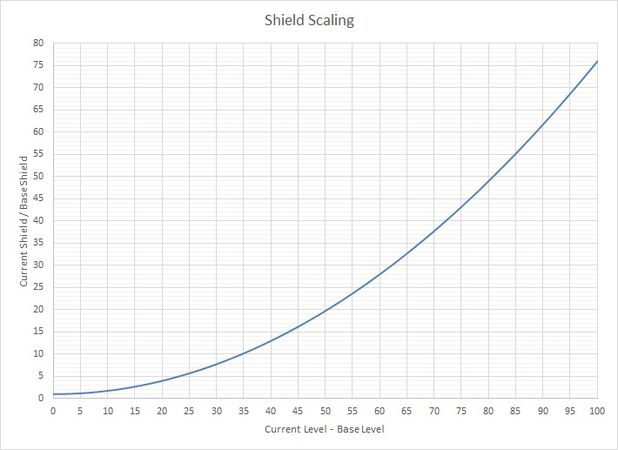
Standardized shield scaling prior to Update 27.2 (2020-03-05). Y-axis indicates ratio of shield at current level to base shield, X-axis indicates the difference between current level and base level.
Armor
The current formula for armor scaling is:
- Current Armor = Base Armor × ( 1 + ( Current Level − Base Level )1.75 × 0.005 )

Standardized armor scaling prior to Update 27.2 (2020-03-05). Y-axis indicates ratio of armor at current level to base armor, X-axis indicates difference between current level and base level.
Damage
This is the base formula for how damage dealt by enemies scales.
- Current Damage = Base Damage × ( 1 + ( Current Level − Base Level )1.55 × 0.015 )
Affinity
The current formula for the scaling of affinity granted upon killing is:
- Current Affinity = Base Affinity × ( 1 + Current Level0.5 × 0.1425 )
Note that this is a special case: for the affinity scaling, base level is not subtracted from the current level! The calculated value is also rounded down to a whole number, e.g. 62.7 affinity will be rounded down to 62.
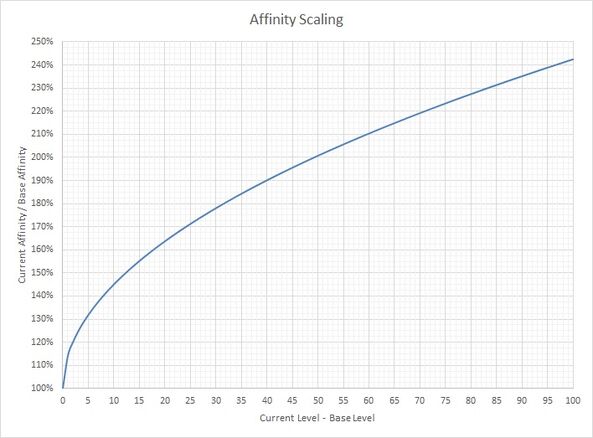
Standardized affinity scaling. Y-axis indicates the ratio of affinity at current level to base affinity, X-axis indicates the current enemy level. The x-axis description in the picture is obsolete, but the x-coordinates reconsidered as current level still yield the correct numbers.
Scaling of Derived Stats
From these fundamental stats, more meaningful stats can be derived.
Effective Hitpoints
Effective Hitpoints is a stat that indicates how much gross damage must be dealt to a target until the net damage thereby inflicted depletes its entire health pool. Effective Hitpoints is not a fixed stat for any given enemy, it is heavily dependent on the damage type used against the target, as well as the various buffs and debuffs in effect for both the attacker and the enemy in question. For the following considerations, however, these influences are disregarded, as they do not alter the course of the graphs except for clinching or stretching them as a whole, which manifests as a scaling of the Y-axis.
For Enemies with Health only
For targets without shields and armor, the standardized effective hitpoint scaling is synonymous with standardized health scaling, the health graph and formula apply.
For Enemies with Health and Shield
The standardized effective hitpoints of shielded enemies are simply the sum of their shields and health, except for the case when the Script error: The function "Proc" does not exist. damage portion of the gross damage depletes the target's health faster than the rest of the gross damage depletes its shield. Exact effective hitpoint calculations considering damage types also become significantly more complex if Toxin damage is involved, but this is disregarded here. The level scaling of standardized effective hitpoints of shielded enemies is influenced by the ratio of base shields to base health, with higher shield portions meaning weaker standardized scaling. However, this may be considered an artifact of standardization, as, in actuality, shield and health simply scale independently from each other and are summed up to the total amount of effective hitpoints. It only means that for the same sum of base health and shield, a higher portion of health will mean better level scaling than a lower portion of health. Regarding the formula, while both are just added to each other, it can be simplified since health and shield share the same exponent:
- Current Effective Hitpoints = ( Base Health + Base Shield ÷ 2 ) × ( 1 + ( Current Level − Base Level )2 × 0.015 ) + Base Shield ÷ 2

Standardized effective hitpoints scaling for shielded, unarmored enemies. Y-axis indicates the ratio of current effective HP to base effective HP, X-axis indicates the difference between current level and base level. Each line applies to a certain ratio of base shield to base health, specified in the key.
For Enemies with Health and Armor
Health and armor synergize in increasing effective hitpoints, as opposed to health and shield which stack only. This makes the effective hitpoint development of armored enemies extremely steep, outclassing that of shielded unarmored enemies significantly, which is why Grineer are considered harder to play against than Corpus at high levels.

Standardized effective hitpoints of armored enemies, linear Y-axis scaling to make values at higher levels more recognizable.
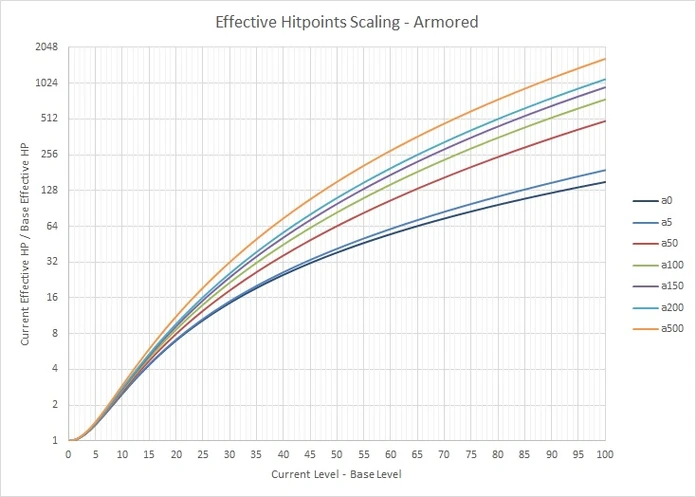
Standardized effective hitpoints of armored enemies, binary logarithmic Y-axis scaling to make values at lower levels more recognizable.
The two figures show exactly the same set of functions, just with different kinds of Y-axis scaling. The different graphs are for different values of net base armor, i.e. the base armor of the enemy type after the reduction from Corrosive Projections and after mitigation for a certain damage type, if applicable. The a0 is an unarmored line for comparison. The used formula is:
- Current Effective Hitpoints = Current Health × ( 1 + Current Armor ÷ 300 )
with Current Health and Armor taken from their respective formulae.
The large impact of the net base armor vividly visualizes how important damage type modifiers against armor types and ![]() Corrosive Projection are at high levels.
Corrosive Projection are at high levels.
For Enemies with Health, Shield and Armor
The effective hitpoints of enemies with health, shield, and armor are the sum of the effective health (i.e. current health and armor incorporated as in the previous formula for armored enemies) and the shield. There is no new aspect of this, but standardization, in this case, is not opportune, as it requires a specification for both the base shield to health ratio and base armor amount, there are more of these combinations than actual enemy types these apply to, and effective hitpoints for shielded and armored enemies may therefore rather be calculated for any specific enemy that fits this category, which goes beyond the scope of this article. Obvious just from comparing the large values of effective hitpoints (armored) to the values of shield alone, the armored health portion of the total effective hitpoints heavily outscales the shield portion, which implies it is generally advantageous to select damage types after the armor's vulnerabilities rather than the shield's vulnerabilities for high level shielded armored enemies. For more accuracy, effective hitpoint portions have to be calculated for specific enemies.
Shielding Ratio
The shielding ratio of shielded, unarmored enemies is the ratio of their shield to their health. Since health and shield scale by different coefficients, this ratio changes with level. In fact, the ratio converges against half of its base value, albeit slowly so over common level ranges. The shielding ratio is relevant for two things: Evaluating and selecting damage types against shielded enemies, i.e. weighing benefits against shield types against benefits against health types, and the scaling behavior of ![]() Mag's
Mag's ![]() Polarize.
Polarize.
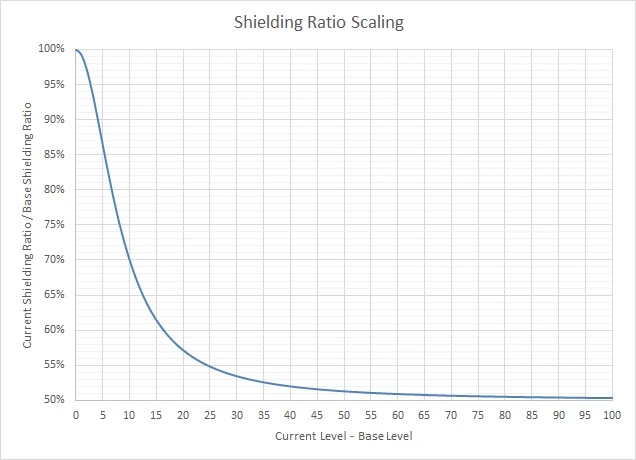
The development of the initial (base) shielding ratio through increasing levels. Current shielding ratio can be obtained by multiplying this quotient at the respective level with the base shielding ratio (i.e. base shield per base health) of the respective enemy type.
Affinity Density
The affinity density of an enemy is its affinity per effective hitpoints and a measure of its profitability for affinity (i.e. experience or reputation) farming.
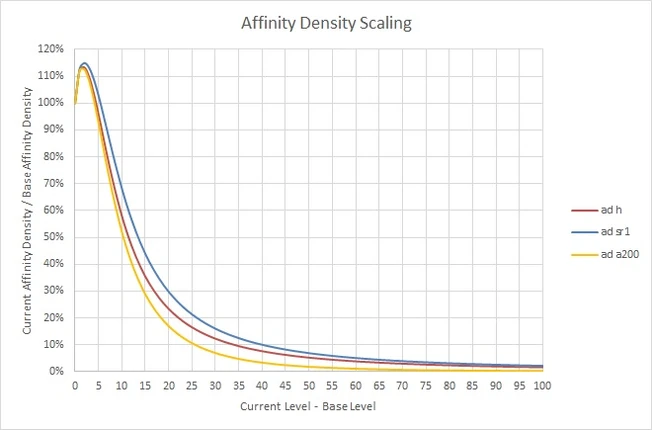
Standardized affinity density scaling for an unprotected enemy, a shielded enemy with a shielding ratio of 1, and an armored enemy with 200 base armor.
Please note that this graph is off due to the underlying assumption that affinity considered the difference between base and current level, just like the other stats, which has since been falsified. The resulting error is small if the enemy has the common base level 1 and the values are looked up for high levels, but if either of these conditions is not satisfied, the error on the y-values is significant. The tendency of the graph is unaffected by this, however: affinity density converges against zero for great levels, regardless.
It is important to note the actual affinity farming profitability is significantly offset off the optimal area as implied by the affinity density function due to the two important practical influences of overkill and retargeting time, which both contribute to shifting the actual optimum from these implications towards higher levels, by a significant but hardly quantifiable amount.
Reflective Kill Rate
Reflective kill rate of an enemy is the ratio of its damage output and effective hitpoints. This is inversely proportional to the amount of time or attacks an enemy would need to kill another of its kind. It's a measurement for the effectiveness of damage reflecting effects and abilities, such as the Script error: The function "Proc" does not exist. damage proc, the ![]() Reflection mod, and abilities such as
Reflection mod, and abilities such as ![]() Link, "Shadows Of The Dead" wasn't found in Module:Ability/data,
Link, "Shadows Of The Dead" wasn't found in Module:Ability/data, ![]() Absorb,
Absorb, ![]() Chaos or
Chaos or ![]() Mind Control.
Mind Control.

Standardized reflective kill rate, i.e. current per base RKR, for an unprotected enemy, a shielded enemy with a shielding ratio of 1, and an armored enemy with 200 base armor.
As you can see, while the absolute damage output of damage reflection abilities does scale with enemy level (see damage scaling figure), it is nevertheless being outscaled by enemies' health and therefore relatively decreasing. As a result, while these abilities do become increasingly impactful with higher levels, they are still insufficient to kill enemies within limited time indefinitely.
Currentness of the Formula
The scaling formula of Warframe has previously been subjected to stealth changes, i.e. without mention in the patch notes, as has been the damage formula. They may have to be re-verified from time to time.
The latest validation for health and shields can be found here. For damage, here. For armor, here.
Patch History
Update 27.2 (2020-03-05)
- Armor and Damage Changes (Enemy):
This section will go over before and after scenarios with our enemy Armor, Health, and Shield changes. Reading this section should give you a conceptual and on-paper understanding of what we’re changing and why, but practical experiences will tell the full story here. You may need to refresh some aspects of your Builds to truly optimize your power against your enemies.
Before: Armor, Shields and Health on an Exponential Curve
After: Armor Shields and Health on an S curve
- Damage Changes:
Enemy Damage output should still be close to what is currently on the Live version of the game, but we have made a few changes that will affect how players take Damage in-game.
Hotfix 25.0.7 (2019-05-30)
- Eximus enemies are now capped at Level 9999 like regular enemies.
Update 11.5 (2013-12-19)
- Armour/Shield/Health/Damage curves have been modified. We’ve lowered the “bullet sponge” to high level enemies, but they now deal more damage. The armour curve was radically dropped. The health and shields curves dropped slightly as well. However, damage output went up.


